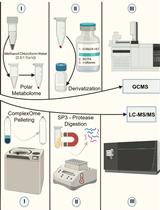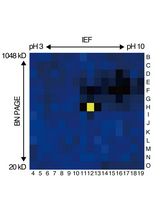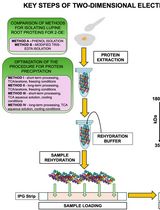- Submit a Protocol
- Receive Our Alerts
- Log in
- /
- Sign up
- My Bio Page
- Edit My Profile
- Change Password
- Log Out
- EN
- EN - English
- CN - 中文
- Protocols
- Articles and Issues
- For Authors
- About
- Become a Reviewer
- EN - English
- CN - 中文
- Home
- Protocols
- Articles and Issues
- For Authors
- About
- Become a Reviewer
Proteolytic Fragment Isolation and Analysis (ex. N-terminal GST-tagged CLAVATA3 Protein GST-CLV3)
Published: Vol 2, Iss 14, Jul 20, 2012 DOI: 10.21769/BioProtoc.232 Views: 12322

Protocol Collections
Comprehensive collections of detailed, peer-reviewed protocols focusing on specific topics
Related protocols

Streamlining Protein Fractional Synthesis Rates Using SP3 Beads and Stable Isotope Mass Spectrometry: A Case Study on the Plant Ribosome
Dione Gentry-Torfer [...] Federico Martinez-Seidel
May 5, 2024 2337 Views

An Activity-Based Proteomics with Two-Dimensional Polyacrylamide Gel Electrophoresis (2D-PAGE) for Identifying Target Proteases in Arabidopsis Apoplastic Fluid
Sayaka Matsui and Yoshikatsu Matsubayashi
Mar 5, 2025 1498 Views

Advancing 2-DE Techniques: High-Efficiency Protein Extraction From Lupine Roots
Sebastian Burchardt [...] Emilia Wilmowicz
Oct 5, 2025 965 Views
Abstract
It has become clear that the post-embryonic growth and development of plants requires properly controlled short distance cell-to-cell communication not only through the historically well-known phytohormones, but also through secreted small peptide signals. This protocol demonstrates an example of how to isolate small peptides (< 10 daltons) from complex protein mixtures (e.g. cauliflower meristem protein extraction) for MS/MS analysis.
Keywords: CLAVATA3Materials and Reagents
- Glutathione Sepharose 4B (Amersham biosciences , catalog number: 17-0756-01 )
- Glutathione (Thermo Fisher Scientific, catalog number: 78259 )
- Protease inhibitor cocktail (Sigma-Aldrich, catalog number: P9599 )
- Triton X-100 (Pierce, catalog number: 85111 )
- GST-mCLV3 proteins
- Tris-HCl
- Hepes (Sigma-Aldrich, catalog number: H3375 )
- EDTA (Sigma-Aldrich, catalog nummber: ED100g )
- Phenylmethylsulfonyl fluoride (Sigma-Aldrich, catalog number: 78830-1G )
- Aprotinin (Sigma-Aldrich, catalog number: A4529-1MG )
- Chymostatin (Sigma-Aldrich, catalog number: C7268-1MG )
- Leupeptin (Sigma-Aldrich, catalog number: L2884-5MG )
- Eluting buffer (see Recipes)
- Cauliflower extraction buffer (see Recipes)
Equipment
- Rotor
- Microcon YM-10 centrifugal filter (EMD Millipore)
- Tabletop centrifuge
- Mass spectrometer (4700 proteomics analyzer)
Procedure
- Cauliflower (Brassica oleracea) meristem protein extracts were prepared as described before (Trotochaud et al., 1999) with or without 0.1% Triton X-100. Note that 1 ml of protease inhibitor cocktail for use with plant cell extracts was added in the extraction buffer per 300 x g of tissues. Before use, the extracts were centrifuged at 40,000 x g for 30 min at 4 °C. It is very important to use fresh cauliflower. We usually try to get cauliflower from local farms. The meristem tissues were collected using razor blade “shaving” the head of the cauliflower.
- Incubate ~100 μg purified GST-mCLV3 proteins (mature CLV3 protrein) with ~400 μl cauliflower protein extracts for 2 h at room temperature (RT) on a rotor.
- For N-terminal tagged fragment (~ 32-34 kD) isolation.
- Bound protein mixtures to Glutathione Sepharose 4B.
- Elute the N-terminal GST containing fragments from the beads with buffer containing 10 mM Glutathione, 50 mM Tris-HCl (pH 8.0).
- If needed, concentrate protein elution using Microcon YM-50 centrifugal filter at 14,000 x g, 4 °C for 30 min and elute in desired volume and buffer (e.g. 0.1% TFA trifluoroacetic acid/water) for MS analysis.
- Bound protein mixtures to Glutathione Sepharose 4B.
- For C-terminal untagged fragment (~ 2-4 kD) isolation.
- Subject protein mixtures to centrifuge through Microcon YM-10 centrifugal filter at 14,000 x g, 4 °C for 30 min.
- Collect the flow-through fractions for intact MS analysis.
- Further characterize peaks of interest by MS/MS analysis (control: Cauliflower protein extracts only; GST-CLV3 incubated with cauliflower extraction buffer).
- Subject protein mixtures to centrifuge through Microcon YM-10 centrifugal filter at 14,000 x g, 4 °C for 30 min.
Recipes
- Eluting buffer
50 mM Tris-HCl
10 mM reduced glutathione (pH 8.0)
- Cauliflower extraction buffer
50 mM Hepes (pH 7.4)
10 mM EDTA
0.1% Triton X-100
1 mM phenylmethylsulfonyl fluoride
5 mg/ml aprotinin
10 mg/ml chymostatin
1 mg/ml leupeptin
For extracts without membrane proteins, exclude Triton X-100 from the buffer.
Acknowledgments
This protocol has been adapted from previous publications including Ni and Clark (2006), Ni et al. (2011) and Trotochaud et al. (1999).
References
- Ni, J. and Clark, S. E. (2006). Evidence for functional conservation, sufficiency, and proteolytic processing of the CLAVATA3 CLE domain. Plant Physiol 140(2): 726-733.
- Ni, J., Guo, Y., Jin, H., Hartsell, J. and Clark, S. E. (2011). Characterization of a CLE processing activity. Plant Mol Biol 75(1-2): 67-75.
- Trotochaud, A. E., Hao, T., Wu, G., Yang, Z. and Clark, S. E. (1999). The CLAVATA1 receptor-like kinase requires CLAVATA3 for its assembly into a signaling complex that includes KAPP and a Rho-related protein. Plant Cell 11(3): 393-406.
Article Information
Copyright
© 2012 The Authors; exclusive licensee Bio-protocol LLC.
How to cite
Ni, J. (2012). Proteolytic Fragment Isolation and Analysis (ex. N-terminal GST-tagged CLAVATA3 Protein GST-CLV3). Bio-protocol 2(14): e232. DOI: 10.21769/BioProtoc.232.
Category
Plant Science > Plant biochemistry > Protein > Isolation and purification
Systems Biology > Proteomics > Whole organism
Biochemistry > Protein > Isolation and purification
Do you have any questions about this protocol?
Post your question to gather feedback from the community. We will also invite the authors of this article to respond.
Tips for asking effective questions
+ Description
Write a detailed description. Include all information that will help others answer your question including experimental processes, conditions, and relevant images.
Share
Bluesky
X
Copy link







